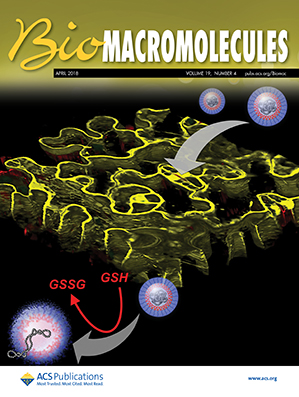具有可调粘弹性的热响应性水凝胶用于延长眼部给药。
IF 5.4
2区 化学
Q1 BIOCHEMISTRY & MOLECULAR BIOLOGY
引用次数: 0
摘要
带电聚合物的构象很大程度上依赖于与周围盐离子的相互作用。通过在透明质酸- pluronic F-127配合物中加入钙离子,我们制备的胶体凝聚体在低温(G′为10 Pa)下粘度降低,在生理温度(G′为19 kPa)下力学性能增强,提高了凝胶的稳定性,延长了药物释放时间。通过改变药物亲脂性,布林唑胺、多唑胺和地塞米松等眼科药物的释放从2周调整为4个月。低粘度水凝胶可以通过结膜下的细针(29G)滴眼液和注射进行局部眼部给药。青光眼药物布林唑胺在兔角膜前停留时间外用48 h以上,结膜下注射23 d以上。这些发现提出了一种改善滴眼液和注射剂的粘弹性,以及通过水凝胶系统延长药物递送时间的方法。本文章由计算机程序翻译,如有差异,请以英文原文为准。
Thermoresponsive Hydrogels with Tunable Viscoelasticity for Extended Ocular Drug Delivery
The conformation of charged polymers is heavily dependent on interactions with the surrounding salt ions. By adding calcium ions to hyaluronan–Pluronic F-127 complexes, we prepared colloidal coacervates with decreased viscosity at cold temperatures (G′ of 10 Pa) and enhanced mechanical properties at physiological temperatures (G′ of 19 kPa) that improved the stability of the gel and prolonged drug release. The release of ophthalmic drugs, brinzolamide, dorzolamide, and dexamethasone, was tuned from 2 weeks to four months by changing drug lipophilicity. The low-viscosity hydrogel enabled topical ocular administration as eye drops and injections via thin needles (29G) under the conjunctiva. The precorneal residence time of glaucoma drug brinzolamide was extended over 48 h after topical administration and over 23 days after subconjunctival injections in rabbits. These findings suggest an approach to improve the viscoelasticity of eye drops and injectables, as well as to prolong drug delivery times via hydrogel systems.
- Download: Download high-res image (168KB)
- Download: Download full-size image
求助全文
通过发布文献求助,成功后即可免费获取论文全文。
去求助
来源期刊

Biomacromolecules
化学-高分子科学
CiteScore
10.60
自引率
4.80%
发文量
417
审稿时长
1.6 months
期刊介绍:
Biomacromolecules is a leading forum for the dissemination of cutting-edge research at the interface of polymer science and biology. Submissions to Biomacromolecules should contain strong elements of innovation in terms of macromolecular design, synthesis and characterization, or in the application of polymer materials to biology and medicine.
Topics covered by Biomacromolecules include, but are not exclusively limited to: sustainable polymers, polymers based on natural and renewable resources, degradable polymers, polymer conjugates, polymeric drugs, polymers in biocatalysis, biomacromolecular assembly, biomimetic polymers, polymer-biomineral hybrids, biomimetic-polymer processing, polymer recycling, bioactive polymer surfaces, original polymer design for biomedical applications such as immunotherapy, drug delivery, gene delivery, antimicrobial applications, diagnostic imaging and biosensing, polymers in tissue engineering and regenerative medicine, polymeric scaffolds and hydrogels for cell culture and delivery.
 求助内容:
求助内容: 应助结果提醒方式:
应助结果提醒方式:


